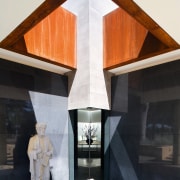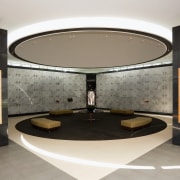leap of faith
A contemporary translation of traditional religious symbolism gives rise to the stunning, yet serene, Fremantle Mausoleum

Built to span the ages, religious buildings nevertheless offer definitive clues to wider architectural trends from their era. And with many cultures devoting considerable resources to their creation, churches, temples and mosques feature amongst the world's most impressive and permanent buildings.
The award-winning Fremantle Mausoleum has surprised and enthused locals since it opened just over a year ago, as much for its highly contemporary use of iconic religious symbolism as for the sleek, clean and modern lines that house it. Importantly, neither aspect has compromised the strong ambience of comfort, dignity and reverence within.
DesignInc architect Jennifer Moen, who was involved in the initial design stages, says the Metropolitan Cemeteries Board wanted a building to accommodate over 1000 crypts, that conveyed an enduring and profoundly religious presence in the Fremantle cemetery landscape.
"Initially, the client discussed their objectives in very traditional architectural vernacular, referring to the classical orders of the Roman Catholic faith," she says. "We were keen to pursue an idea that the building would be grounded in traditional materials, like concrete and marble, as well as the symbolism attached to that, such as the dome, pyramid and the crucifix. But we wanted to elaborate on those classical and timeless themes in a non-traditional way."
It took a leap of faith on the client's part, says Moen, to invest as much trust in the architects as they did.
"Our vision for the building was to express an abundance of spiritual allegory, as per the client's brief, without being literal."
The plan of the mausoleum does, though, pay homage to cruciform imagery in its cross-shaped layout. The dome and pyramid structures atop the two main crypt sanctuaries are sited on the upper west and east side of the building. Two external covered areas are located on the lower west and east side of the plan as congregation areas.

Spatially, the building has been designed to accommodate interment services attended by intimate or large gatherings. Processional cars arrive and leave in a one-way system under a large covered area on the front side of the building.
To give families a choice of costs, three simple external structures housing crypts are located in the gardens and are accessed from the eastern side of the colonnade.
Situated within the grounds of the existing Fremantle cemetery, the mausoleum was built between the original grave sites, giving the building an immediate sense of permanence. A deliberate point of asymmetry was created by using a dome and a pyramid on the roof. Providing a strong link to traditional Christian symbolism, the roof lines dictate the shape of the interment rooms situated below.
Low leather seating on dark carpet is surrounded by grey and white marble-faced crypts stacked six high, each with a silver repository for flowers. Discrete halogen track lighting is shaped to fit the ceiling shape.
To enter the rooms, visitors cross a short boardwalk over long, shallow water pools, an extension of the cross-shaped one on which the figure of Jesus stands. The water, the boardwalk and the reference to Jesus as a fisherman as well as the sun streaming through the glasswork above are all reflections of the heritage and culture of Fremantle and its environs, explains Moen.
"On a more esoteric level, we also saw the importance and meaning that water and sunlight plays in representing the spiritual realm."
With up to 500 people gathering in and around the interment rooms, a strong component of the design criteria was the requirement for a passive ventilation and lighting system, so mourners would find the ambient room temperature and environment comfortable and noiseless.
This was achieved by placing sensor monitors on the walls one metre above floor level. When CO2 levels reach a certain threshold, ceiling louvres open discretely, providing cross ventilation. In summer, a night purge system works on a temperature control sensor to cool the empty building down in the same way. Large, cruciform-shaped glass areas on the entry side of the building allow daylight to stream inside, minimising the need for interior lighting.
Metropolitan Cemeteries Board CEO, Peter MacLean, reports a high level of satisfaction with the building.
"We regard the mausoleum as a very special building grand and character-filled," he says. "We also feel the other client, the public, are certainly grateful to have the use of such a facility. The design nestles well into the landscape and is now a focal point for the Fremantle cemetery."
Two main churches in the area were consulted about the use of statues and religious icons the mausoleum's acceptance within the wider community as an interdenominational facility being naturally important to the client, says Moen.
"We had an excellent relationship with the client who, crucially for the success of the project and despite having many traditional obligations to fulfil in creating a mausoleum, was open to strong and contemporary expressions of architecture."
Credit list
Architects
Builder
Structural and civil engineer
Electrical engineer
Landscaping
Marble, granite and stone tiling
Copperform
Stonework
Client
Project manager
Mechanical engineer
Hydraulics
Quantity surveyor
Roof material
Glazing
Glass Mosaic
Story by: Trendsideas
Home kitchen bathroom commercial design
From farmhouse to farmstead
Walk this way – garden pathways to lead your thinking
Objets central














